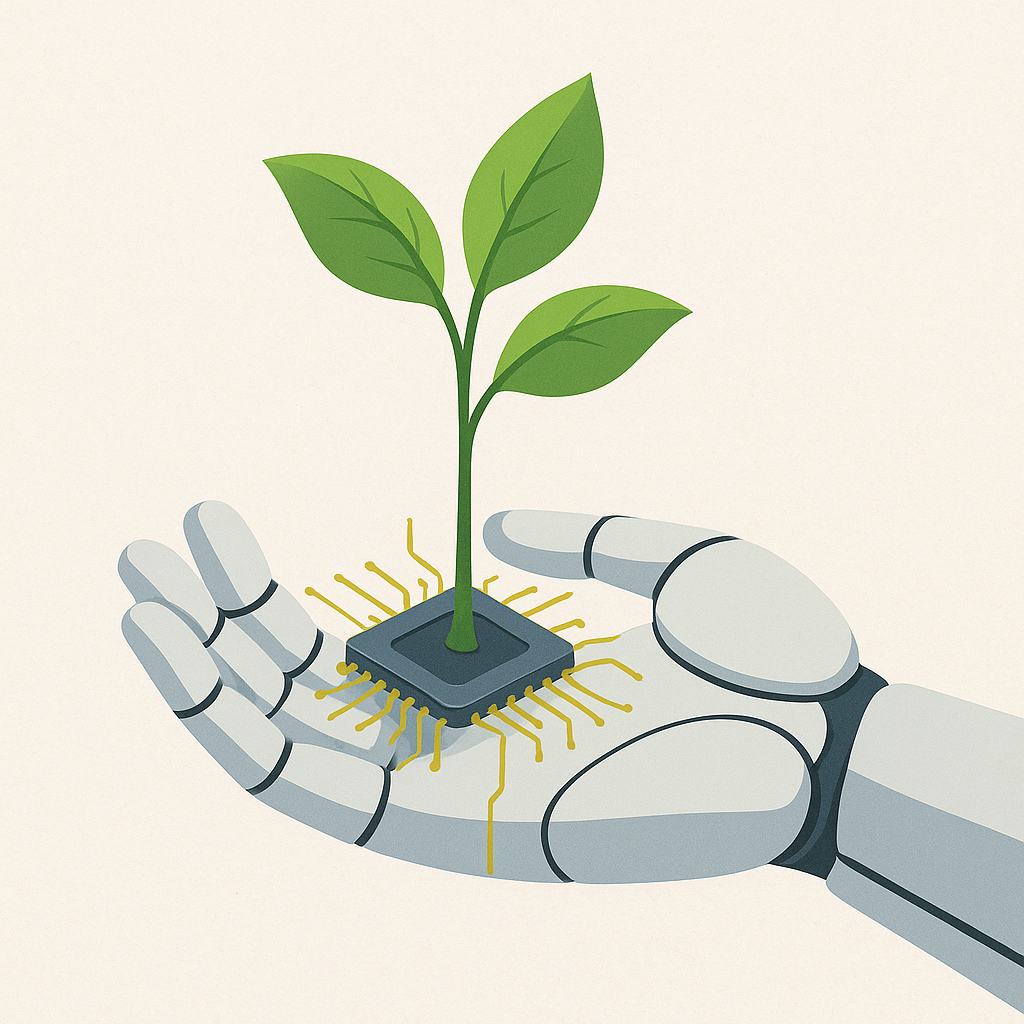Artificial Intelligence (AI) is transforming how the world works — revolutionizing industries, improving decision-making, and accelerating solutions for global challenges like climate change. Yet behind this rapid progress lies a growing concern: the environmental footprint of AI.
As AI systems grow in complexity and scale, the energy and resources required to train, run, and maintain them increase dramatically. Understanding this impact is key to ensuring that innovation aligns with global sustainability goals.

⚡ 1. The Hidden Energy Behind AI Training
Training advanced AI systems — especially large-scale models such as GPTs, image diffusion models, and deep neural networks — requires massive computational resources. Each training phase involves processing vast amounts of data across thousands of GPUs or TPUs, often running for weeks or months.
According to several studies and reports:
-
Training a single large language model can emit as much CO₂ as several cars over their entire lifetime (Luccioni et al., Hugging Face, 2023).
-
Global data center electricity demand (driven partly by AI) could exceed 945 TWh by 2030, according to the International Energy Agency (IEA) (IEA, 2024).
-
In the U.S., data centers already consume around 4.4% of total electricity — a number expected to triple by 2028 (Penn State Institute of Energy and the Environment, 2024).
Even as hardware efficiency improves, the overall demand for AI compute continues to outpace those gains.
💧 2. Water and Cooling Demands
AI’s footprint extends beyond electricity. Data centers also consume large volumes of water for cooling, especially in warmer climates.
Key findings include:
-
Large data centers can use up to 5 million gallons of water per day for cooling — equivalent to the daily needs of a small town (Environmental and Energy Study Institute, 2023).
-
Google and Microsoft together reportedly used over 580 billion gallons of water in 2022 to power and cool AI-related infrastructure (Food & Water Watch, 2025).
-
Many companies still do not publicly disclose the water and energy used by their AI operations (Federation of American Scientists, 2024).
🗑️ 3. The Lifecycle of AI Hardware
AI systems depend on specialized chips such as GPUs and TPUs, which require rare earth minerals and resource-intensive manufacturing processes.
These supply chains contribute to carbon emissions, toxic waste, and environmental degradation, while rapid hardware turnover fuels the global e-waste crisis.
As highlighted by sustainability researchers, “AI hardware lifecycles are short — leading to increased manufacturing emissions and waste generation” (University of Maryland, 2025).
🌱 4. AI for Environmental Good
Ironically, AI can also be a powerful ally in sustainability efforts when deployed responsibly. Examples include:
-
Climate modeling: AI improves long-term climate forecasts and weather prediction accuracy (University of Illinois, 2025).
-
Energy optimization: Smart grids use AI to reduce energy waste in homes, cities, and industries.
-
Conservation: Machine learning supports biodiversity monitoring, detects illegal deforestation, and tracks endangered species.
In other words, AI can help solve the same environmental challenges it contributes to — depending on how it’s used.
⚖️ 5. Toward Greener AI
The technology community is actively seeking ways to reduce AI’s carbon footprint, including:
-
Building greener data centers powered by renewable energy (MIT Sloan, 2025).
-
Improving model efficiency using pruning, quantization, and architectural optimization techniques (arXiv:2204.02766).
-
Increasing transparency around AI energy and water usage (Brookings Institution, 2024).
-
Developing measurement tools for carbon and water accounting in AI operations (Google Cloud Blog, 2024).
This growing movement — often called “Green AI” — focuses on designing and deploying AI systems that maximize performance while minimizing environmental impact.

🌎 Conclusion
AI’s environmental impact presents a powerful paradox: it is both a driver of climate strain and a potential instrument for sustainability.
The challenge lies in balancing technological progress with ecological responsibility, ensuring that intelligence and innovation do not come at the planet’s expense.
A sustainable AI future will require collaboration between governments, researchers, tech companies, and individuals alike.
Because the smartest future we can build — is a green one.
📚 References
-
As Use of A.I. Soars, So Does the Energy and Water It Requires — Yale E360
https://e360.yale.edu/features/artificial-intelligence-climate-energy-emissions -
Explained: Generative AI’s Environmental Impact — MIT News
https://news.mit.edu/2025/explained-generative-ai-environmental-impact-0117 -
AI is Set to Drive Surging Electricity Demand from Data Centres — IEA
https://www.iea.org/news/ai-is-set-to-drive-surging-electricity-demand-from-data-centres-while-offering-the-potential-to-transform-how-the-energy-sector-works -
Data Centers and Water Consumption — Environmental & Energy Study Institute (EESI)
https://www.eesi.org/articles/view/data-centers-and-water-consumption -
Policy Primer: The Environmental Impacts of AI — Sasha Luccioni (Hugging Face)
https://www.sashaluccioni.com/assets/AI%20%2B%20Environment%20Primer%20(Hugging%20Face).pdf -
Measuring the Environmental Impact of AI Inference — Google Cloud Blog
https://cloud.google.com/blog/products/infrastructure/measuring-the-environmental-impact-of-ai-inference -
As Energy Demands for AI Increase, So Should Company Transparency — Brookings Institution
https://www.brookings.edu/articles/as-energy-demands-for-ai-increase-so-should-company-transparency
(This post is generated by ChatGPT)
الآثار البيئية للذكاء الاصطناعي: موازنة الابتكار مع الاستدامة
يُعد الذكاء الاصطناعي (AI) أحد أهم الابتكارات التقنية في عصرنا، إذ يُحدث تحولًا جذريًا في مختلف القطاعات، ويُحسِّن عملية اتخاذ القرار، ويسرّع إيجاد الحلول للتحديات العالمية مثل التغير المناخي. لكن، وراء هذا التقدم المذهل تكمن بصمة بيئية متنامية تستدعي الانتباه.
فمع تزايد تعقيد النماذج الذكية واتساع نطاق استخدامها، يرتفع بشكل كبير استهلاك الطاقة والموارد اللازمة لتدريبها وتشغيلها وصيانتها. وفهم هذا الأثر ضروري لضمان توافق الابتكار مع أهداف الاستدامة العالمية.

⚡ 1. الطاقة الخفية وراء تدريب أنظمة الذكاء الاصطناعي
يتطلب تدريب الأنظمة المتقدمة للذكاء الاصطناعي — وخاصة النماذج الضخمة مثل GPT أو الشبكات العصبية العميقة — قدرات حوسبة هائلة.
تتضمن كل مرحلة من التدريب معالجة كميات ضخمة من البيانات عبر آلاف المعالجات الرسومية (GPU) أو وحدات المعالجة المخصصة (TPU) التي تعمل لأسابيع أو حتى أشهر.
تشير الدراسات والتقارير إلى ما يلي:
-
تدريب نموذج لغوي واحد كبير يمكن أن يصدر كمية من انبعاثات ثاني أكسيد الكربون تساوي ما تصدره عدة سيارات طوال عمرها التشغيلي
(Luccioni et al., Hugging Face, 2023) -
من المتوقع أن يتجاوز استهلاك مراكز البيانات للكهرباء عالميًا 945 تيراواط/ساعة بحلول عام 2030، وفقًا لتقديرات الوكالة الدولية للطاقة (IEA)
(IEA, 2024) -
في الولايات المتحدة، تستهلك مراكز البيانات حاليًا نحو 4.4٪ من إجمالي الكهرباء، مع توقع تضاعف هذه النسبة ثلاث مرات بحلول عام 2028
(Penn State Institute of Energy and the Environment, 2024)
ورغم التحسن في كفاءة الأجهزة والخوارزميات، فإن الطلب العالمي المتزايد على قدرات الذكاء الاصطناعي يفوق المكاسب المحققة في الكفاءة.
💧 2. استهلاك المياه ومتطلبات التبريد
لا تقتصر البصمة البيئية للذكاء الاصطناعي على استهلاك الكهرباء فقط. فمراكز البيانات تستهلك أيضًا كميات هائلة من المياه لتبريد المعدات، خاصة في المناطق ذات المناخ الحار.
وتشير البيانات إلى أن:
-
بعض مراكز البيانات الكبرى تستخدم ما يصل إلى 5 ملايين جالون من المياه يوميًا لأغراض التبريد، أي ما يعادل استهلاك مدينة صغيرة بأكملها.
(Environmental and Energy Study Institute, 2023) -
شركتا Google وMicrosoft استخدمتا معًا أكثر من 580 مليار جالون من المياه في عام 2022 لتشغيل وتبريد بنيتهما التحتية الخاصة بالذكاء الاصطناعي.
(Food & Water Watch, 2025) -
العديد من الشركات لا تزال لا تفصح بشفافية عن استهلاكها للطاقة والمياه في عمليات الذكاء الاصطناعي.
(Federation of American Scientists, 2024)
🗑️ 3. دورة حياة مكونات الذكاء الاصطناعي
تعتمد أنظمة الذكاء الاصطناعي على رقائق إلكترونية متخصصة (مثل وحدات GPU وTPU) تتطلب معادن نادرة وعمليات تصنيع معقدة.
وتساهم هذه العمليات في انبعاثات كربونية ونفايات سامة وتدهور بيئي، بينما تؤدي سرعة التطور التقني إلى زيادة النفايات الإلكترونية عالميًا نتيجة قِصر عمر الأجهزة.
كما أشار باحثو الاستدامة في جامعة ميريلاند، فإن «دورة حياة مكونات الذكاء الاصطناعي قصيرة، مما يزيد من انبعاثات التصنيع والنفايات الإلكترونية».
(University of Maryland, 2025)
🌱 4. الذكاء الاصطناعي لخدمة البيئة
من المفارقات أن الذكاء الاصطناعي يمكن أن يكون أداة فعالة لتحقيق الاستدامة البيئية إذا استُخدم بطريقة مسؤولة. ومن أبرز تطبيقاته في هذا المجال:
-
النمذجة المناخية: يستخدم الذكاء الاصطناعي لتحسين دقة التنبؤات الجوية والتغيرات المناخية طويلة الأمد.
(University of Illinois, 2025) -
ترشيد استهلاك الطاقة: تُسهم الأنظمة الذكية في إدارة شبكات الكهرباء بكفاءة وتقليل الهدر في الاستخدام المنزلي والصناعي.
-
الحفاظ على الطبيعة: تساعد خوارزميات التعلم الآلي في مراقبة التنوع البيولوجي، واكتشاف إزالة الغابات غير القانونية، وتتبع الأنواع المهددة بالانقراض.
بعبارة أخرى، يمكن للذكاء الاصطناعي أن يحلّ المشكلات البيئية التي ساهم في تفاقمها — إذا تم استخدامه بشكل واعٍ.
⚖️ 5. نحو ذكاء اصطناعي أكثر استدامة
يعمل مجتمع التكنولوجيا اليوم على تقليل البصمة الكربونية للذكاء الاصطناعي من خلال مبادرات عدة، منها:
-
إنشاء مراكز بيانات صديقة للبيئة تعتمد على الطاقة المتجددة.
(MIT Sloan, 2025) -
تحسين كفاءة النماذج باستخدام تقنيات مثل تقليم الشبكات وتقليل دقة الحسابات وتصميم هياكل أكثر كفاءة.
(arXiv:2204.02766) -
تعزيز الشفافية حول استهلاك الطاقة والمياه في أنظمة الذكاء الاصطناعي.
(Brookings Institution, 2024) -
تطوير أدوات لقياس البصمة البيئية للذكاء الاصطناعي من حيث الانبعاثات واستهلاك الموارد.
(Google Cloud Blog, 2024)
ويُعرف هذا التوجه المتنامي باسم «الذكاء الاصطناعي الأخضر» (Green AI)، الذي يهدف إلى تصميم وتشغيل أنظمة أكثر كفاءة وصداقة للبيئة.

🌎 الخلاصة
يحمل الأثر البيئي للذكاء الاصطناعي مفارقة واضحة: فهو في الوقت نفسه يسهم في الضغط البيئي والمناخي ويوفر أدوات لمواجهته.
والتحدي الحقيقي يكمن في تحقيق التوازن بين التقدم التقني والمسؤولية البيئية، لضمان أن الابتكار لا يأتي على حساب الكوكب.
إن بناء مستقبل مستدام للذكاء الاصطناعي يتطلب تعاونًا بين الحكومات والباحثين والشركات والأفراد على حد سواء.
فالمستقبل الذكي لا بد أن يكون أيضًا مستقبلًا أخضر.
📚 المراجع
-
As Use of A.I. Soars, So Does the Energy and Water It Requires — Yale E360
https://e360.yale.edu/features/artificial-intelligence-climate-energy-emissions -
Explained: Generative AI’s Environmental Impact — MIT News
https://news.mit.edu/2025/explained-generative-ai-environmental-impact-0117 -
AI is Set to Drive Surging Electricity Demand from Data Centres — IEA
https://www.iea.org/news/ai-is-set-to-drive-surging-electricity-demand-from-data-centres-while-offering-the-potential-to-transform-how-the-energy-sector-works -
Data Centers and Water Consumption — Environmental & Energy Study Institute (EESI)
https://www.eesi.org/articles/view/data-centers-and-water-consumption -
Policy Primer: The Environmental Impacts of AI — Sasha Luccioni (Hugging Face)
https://www.sashaluccioni.com/assets/AI%20%2B%20Environment%20Primer%20(Hugging%20Face).pdf -
Measuring the Environmental Impact of AI Inference — Google Cloud Blog
https://cloud.google.com/blog/products/infrastructure/measuring-the-environmental-impact-of-ai-inference -
As Energy Demands for AI Increase, So Should Company Transparency — Brookings Institution
https://www.brookings.edu/articles/as-energy-demands-for-ai-increase-so-should-company-transparency
(تم توليد هذه المقالة باستخدام تشات جي بي تي)
